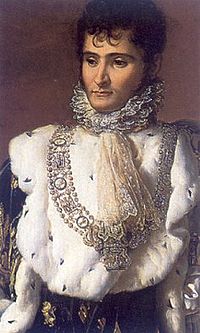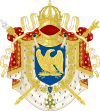Jérôme Bonaparte
| Jérôme I | |||||
|---|---|---|---|---|---|
 Portrait of Jérôme I by François Gérard | |||||
| King of Westphalia | |||||
| Reign | 8 July 1807 – 26 October 1813 | ||||
| Prince of Montfort | |||||
| Tenure | July 1816 – 24 June 1860 | ||||
| Born | 15 November 1784 Ajaccio, Corsica | ||||
| Died | 24 June 1860 (aged 75) Villegenis, France | ||||
| Spouse | Elizabeth Patterson Catharina of Württemberg Giustina Pecori-Suárez | ||||
| Issue | Jérôme Napoléon Bonaparte-Patterson Jérôme Napoléon Charles Bonaparte Mathilde Bonaparte, Princesse de San Donato Napoléon Joseph Charles Paul Bonaparte Illegitimate: Karl Philipp Heinrich Bach | ||||
| |||||
| House | Bonaparte | ||||
| Father | Carlo Buonaparte | ||||
| Mother | Letizia Ramolino | ||||
| Religion | Roman Catholicism | ||||
| Signature | |||||
Jérôme-Napoléon Bonaparte (15 November 1784 – 24 June 1860) was the youngest brother of Napoleon I and reigned as Jerome I, King of Westphalia, between 1807 and 1813. From 1816 onward, he bore the title of Prince of Montfort.[1] After 1848, when his nephew, Louis Napoleon, became President of the French Second Republic, he served in several official roles, including Marshal of France from 1850 onward, and President of the Senate in 1852.[2]
Early life
Jérôme was born Girolamo Buonaparte in Ajaccio, Corsica the eighth and last surviving child, fifth surviving son, of Carlo Buonaparte and Letizia Ramolino. He was a younger brother of his siblings: Joseph Bonaparte, Napoleon Bonaparte, Lucien Bonaparte, Elisa Bonaparte, Louis Bonaparte, Pauline Bonaparte and Caroline Bonaparte.


He studied at the Catholic College of Juilly, and then served with the French Navy before going to the United States. On Christmas Eve, 24 December 1803, nineteen-year-old Jérôme married Elizabeth ("Betsy") Patterson (1785–1879), eighteen-year-old daughter of prosperous ship-owner and merchant William Patterson, (1752–1835) in Baltimore, (then the third-largest city in America). Napoleon was unable to convince Pope Pius VII in Rome to annul their marriage, and so annulled the marriage himself (by a French imperial decree, 11 March 1805), as a matter of state. Elizabeth was pregnant with a son at the time, (Jérôme Napoléon Bonaparte (1805–1870)), and was on her way to Europe with the elder Jérôme. When they landed in neutral Portugal, Jérôme set off overland to Italy to attempt to convince his brother to recognize the marriage. Elizabeth then attempted to land in Amsterdam, hoping to travel to within the borders of France in order for her and Jerome's baby son to be born on French soil, but Emperor Napoleon I issued orders barring the ship from entering the harbour. Being with child, Elizabeth went on to England where Jérôme Napoléon Bonaparte, (later nicknamed in childhood as "Bo"), was born at 95 Camberwell Grove, Camberwell, London, England. Emperor Napoleon instituted Roman Catholic and later French state divorce proceedings only after the birth of the baby, Jerome II. After considerable delay and internal struggle, Elizabeth was later declared divorced from Jerome by a special decree and act of the state legislature of the General Assembly of Maryland in 1815.
King of Westphalia
| King of Westphalia | |
|---|---|
 Royal Coat of arms | |
 Jérôme I | |
| Details | |
| Style | His Majesty |
| First monarch | Jérôme I |
| Last monarch | Jérôme I |
| Formation | 8 July 1807 |
| Abolition | 26 October 1813 |
| Appointer | Hereditary |
| Pretender(s) | Charles, Prince Napoléon |
Napoleon made his brother King of Westphalia, the short-lived realm (1807–13), created, by Napoleon, from the several states and principalities in northwestern Germany (in the former thousand-year old Holy Roman Empire). It was later reorganized by Napoleon into the Confederation of the Rhine and then after his defeat, the Allies were to reorganise the German states into a German Confederation with Austrian leadership, largely overriding prior claim of lesser states.
The Napoleonic realm of Westphalia had its capital in Kassel (then: Cassel). Jérôme was married, as arranged by Napoleon, to HRH Princess Catharina of Württemberg, the daughter of Frederick I, King of Württemberg. A marriage to a German princess was intended to boost the dynastic standing of the young French king.
When Jérôme and Catharina arrived in Kassel, they found the palaces in a plundered state. As such, they placed orders for an array of stately furniture and expensive silverware with leading Parisian manufactures. Local artisans, eager for commissions, oriented themselves with these French models. The King also intended to refurbish his capital architecturally. The court theatre ranks among the small number of projects realised. Jérôme had it designed by Leo von Klenze and constructed next to the summer residence, previously known as "Wilhelmshöhe", it was changed to "Napoleonshöhe". To emphasize his rank as a ruler, and pander to his own ego, Jérôme commissioned grandiose state portraits of himself and his spouse, Queen Catharina. Other paintings were to celebrate his military exploits, with many of France's most prominent painters taken into his employ.
As a model state, the Kingdom of Westphalia was expected by Napoleon to serve as an example for the other German states. It received the first constitution and parliament to be found on German soil (decades before other parliaments, legislatures, reichstags, bundesrats, etc. such as in Frankfurt in 1848). Jérôme imported the Empire style from Paris, bestowing the new state with a modern, representative appearance. The small kingdom thus received more attention since the famous "Treaty of Westphalia" which ended the Thirty Years' War a hundred and fifty years earlier in 1648. Thanks to these efforts by King Jerome, Kassel celebrated an enormous cultural upturn.
However, Jérôme's expensive habits earned him the contempt of Napoleon. His court incurred expenses comparable to Napoleon's court (which oversaw a vastly larger and more important realm), and Napoleon refused to support Jérôme financially.[3]
In 1812, Jérôme was given command of a corps in the "Grande Armée", marching towards Minsk. Insisting on travelling "in state", Napoleon reprimanded Jerome, ordering him to leave his court and luxurious trappings behind. After the Battle of Mir (1812) Jérome occupied Mir Castle. In pique, of Napoleon's order, Jérôme returned with his entire court and train to Westphalia. After the defeat in Russia, the following winter, Jerome petitioned Napoleon to allow his wife to come to Paris, fearing the advance of the Allied armies. On the second attempt, Napoleon granted permission.
Jérôme briefly re-entered the army in 1813, when his Kingdom was being threatened from the east by the advancing allied Prussian and Russian armies. He led a small force to challenge their invasion. Following a clash with an enemy detachment, he made camp with his army, hoping for reinforcements from the French army in the west. However, before reinforcements arrived the main allied force captured the capital Kassel. The Kingdom of Westphalia was declared dissolved and Jérôme's kingship ended. He then fled to join his wife, the former queen, in France.
The Hundred Days


During the "Hundred Days", Napoleon placed Jérôme in command of the 6th Division of the II Corps under General Honoré Charles Reille. At Waterloo, Jérôme's division was to make an initial attack on Hougoumont. It is said that Napoleon wished to draw in Lord Wellington's reserves. Whatever the intent, Jérôme was allowed to enlarge the assault such that his division became completely engaged attempting to take Hougoumont to the exclusion of any other possible deployment, without significantly weakening Wellington's centre.
Later years
Although Catharina was aware of Jérôme's womanising and affairs, she remained true to her husband. They had a son, Napoléon Joseph Charles Paul Bonaparte (1822–1891), also known as "Prince Napoleon" or "Plon-Plon." Their second child, a daughter, Princess Mathilde Bonaparte, was a prominent hostess during and after the Second French Empire of Napoleon III (1852–70).
After the dissolution of his Kingdom, Jérôme was given the title of "Prince of Montfort" (French: prince de Montfort)[4] by his father-in-law, King Frederick I of Württemberg, in July 1816.[5] Previously, in 1814, the King had forced Jérôme and his wife to leave the country. During their exile, they visited the United States (his second time). Jérôme later returned to France and joined Napoleon during attempt to restore the Empire during the "Hundred Days".
Later, Jérôme moved to Italy, where he married his third wife, Giustina Pecori-Suárez. She was the widow of an Italian Marquess, Luigi Bartolini-Baldelli.
In 1848, his nephew, Prince Louis Napoleon, became President of the second French Republic. Jérôme was made governor of Les Invalides in Paris, which was the burial place of Napoleon I. When Louis Napoleon became emperor as Napoleon III, Jérôme was recognized as the heir presumptive to the re-established imperial throne until the birth of Napoléon Eugène, Prince Imperial. Jérôme was named a Marshal of France in 1850, served as President of the Senate (the upper house in the French Republic's parliament, compared with the lower house of the National Assembly) in 1852, and received the title of "Prince Français".
Jérôme Bonaparte died on 24 June 1860, at Villegenis, France (today known as Massy in Essonne). He is buried in Les Invalides.
His grandson, Charles Joseph Bonaparte (son of Jerome "Bo" Napoleon Bonaparte, 1805–1870), served as United States Secretary of the Navy and United States Attorney General in President Theodore Roosevelt's administration, 1901-1909. In 1908, he established a Bureau of Investigation within the 38-year-old Department of Justice. The bureau grew under director J. Edgar Hoover and was renamed the Federal Bureau of Investigation in 1935.
Another grandson was Jerome Napoleon Bonaparte II, (1829–1893). In the early 1850s, he graduated from the United States Military Academy at West Point, was commissioned an officer in the United States Army, and served with the Mounted Rifles in Texas on the American southwestern frontier. He eventually resigned his commission and joined the forces of his cousin, the Emperor Napoleon III in his second French Empire.
Among Jérôme Bonaparte's illegitimate children was Baroness Jenny von Gustedt, born as Jeromée Catharina Rabe von Pappenheim (1811–1890). She became the grandmother of the German Socialist and Feminist writer Lily Braun.
In fiction and popular culture
The 1923 German comedy film The Little Napoleon is loosely based around his life. He is played by Paul Heidemann.
In the Hornblower television series, he was portrayed by British actor David Birkin. The last episode (Duty) introduces Jérôme and Elizabeth ('Betsy'). Adrift in an open boat, they are picked up by Captain Hornblower's ship; Jérôme poses as a harmless Swiss citizen, but Hornblower identifies him. After many diplomatic manoeuvres, the British government decides that Jérôme is of no political importance after all, and he is allowed to return to France while Elizabeth put aboard a passing American ship.
Jerome and Betsy's marriage is portrayed in the historical novel "The Ambitious Madame Bonaparte" by Ruth Hull Chatlien, published in 2013.
Jérôme may have been a source of inspiration for the character of Prince Hans, the primary antagonist of Disney's 2013 movie musical Frozen.[citation needed]
Family


- Jérôme Napoléon Bonaparte (1805–1870)
- Jerome Napoleon Bonaparte II (1830–1893)
- Louise-Eugénie Bonaparte (1873–1923)
- Jerome Napoleon Charles Bonaparte (1878–1945)
- Charles Joseph Bonaparte (1851–1921)
- Jerome Napoleon Bonaparte II (1830–1893)
- Jérôme Napoléon Charles Bonaparte (1814–1847)
- Mathilde Bonaparte (1820–1904), married Anatole Demidoff, 1st Prince of San Donato
- Napoléon Joseph Bonaparte (1822–1891), married Princess Clotilde of Savoy
- Napoléon Victor Bonaparte (1862–1926), married Princess Clémentine of Belgium
- Clotilde Bonaparte (1912–1996), married Serge de Witt
- Louis Bonaparte (1914–1997), married Alix de Foresta
- Charles Bonaparte (1950–), married Princess Béatrice of Bourbon-Two Sicilies, Jeanne-Françoise Valliccioni
- Caroline Napoléon Bonaparte (1980–)
- Jean-Christophe Napoléon Bonaparte (1986–)
- Sophie Cathérine Bonaparte (1992–)
- Catherine Bonaparte (1950–), married Marquis Nicola di San Germano, Jean Dualé
- Laura Bonaparte (1952–), married Jean-Claude Leconte
- Jérôme Xavier Bonaparte (1957–)
- Charles Bonaparte (1950–), married Princess Béatrice of Bourbon-Two Sicilies, Jeanne-Françoise Valliccioni
- Napoléon Louis Joseph Jérôme Bonaparte (1864–1932)
- Maria Letizia Bonaparte (1866–1926), married Amedeo, 1st Duke of Aosta
- Napoléon Victor Bonaparte (1862–1926), married Princess Clémentine of Belgium
Titles, styles and arms
| Monarchical styles of Jérôme I of Westphalia | |
|---|---|
 | |
| Reference style | His Majesty |
| Spoken style | Your Majesty |
| Alternative style | Sire |
Titles and styles
- 15 November 1784 - circa 1795: Nobile Girolamo Buonaparte
- circa 1795 - 1806: Jerome Bonaparte
- 1806 - 8 July 1807: Jerome-Napoleon, French Prince
- 8 July 1807 - 26 October 1813: His Majesty Hieronymus, The King of Westphalia [6]
- 31 July 1816 - 2 December 1852: Jerome-Napoleon, Prince of Montfort
- 2 December 1852 - 18 June 1860: Jerome-Napoleon, French Prince, Prince of Montfort
Full title
His Majesty Jérôme Napoleon I, By the Grace of God and by the Constitution, King of Westphalia
Ancestry
| Family of Jérôme Bonaparte | ||||||||||||||||||||||||||||||||||||||||||||||||||||||||||||||||||||||||||||||||||||||||||||||||||||||||||||||||||||||||||||||||||||||||||||||||||||||||||||||||||||||||||||||||||||||||||||||||||||||||||||||||||||||||||||||||||||||||||||||||||||||||||||||||||||||||||||||||||||||||||||||||||||||||||||||||||||||||||||||||||||||||||||||||||||||||||||||||||||||||||||||||||||||||||||||||||||||||||||||||||||||||||||||||||||||||||||||||||||||||||||||||||||||||||||||||||||||||||||||||||||||||||||||||||||||||||||||||||||||||||||||||||||||||||||||||||||||||||||||||||||||||||||||||
|---|---|---|---|---|---|---|---|---|---|---|---|---|---|---|---|---|---|---|---|---|---|---|---|---|---|---|---|---|---|---|---|---|---|---|---|---|---|---|---|---|---|---|---|---|---|---|---|---|---|---|---|---|---|---|---|---|---|---|---|---|---|---|---|---|---|---|---|---|---|---|---|---|---|---|---|---|---|---|---|---|---|---|---|---|---|---|---|---|---|---|---|---|---|---|---|---|---|---|---|---|---|---|---|---|---|---|---|---|---|---|---|---|---|---|---|---|---|---|---|---|---|---|---|---|---|---|---|---|---|---|---|---|---|---|---|---|---|---|---|---|---|---|---|---|---|---|---|---|---|---|---|---|---|---|---|---|---|---|---|---|---|---|---|---|---|---|---|---|---|---|---|---|---|---|---|---|---|---|---|---|---|---|---|---|---|---|---|---|---|---|---|---|---|---|---|---|---|---|---|---|---|---|---|---|---|---|---|---|---|---|---|---|---|---|---|---|---|---|---|---|---|---|---|---|---|---|---|---|---|---|---|---|---|---|---|---|---|---|---|---|---|---|---|---|---|---|---|---|---|---|---|---|---|---|---|---|---|---|---|---|---|---|---|---|---|---|---|---|---|---|---|---|---|---|---|---|---|---|---|---|---|---|---|---|---|---|---|---|---|---|---|---|---|---|---|---|---|---|---|---|---|---|---|---|---|---|---|---|---|---|---|---|---|---|---|---|---|---|---|---|---|---|---|---|---|---|---|---|---|---|---|---|---|---|---|---|---|---|---|---|---|---|---|---|---|---|---|---|---|---|---|---|---|---|---|---|---|---|---|---|---|---|---|---|---|---|---|---|---|---|---|---|---|---|---|---|---|---|---|---|---|---|---|---|---|---|---|---|---|---|---|---|---|---|---|---|---|---|---|---|---|---|---|---|---|---|---|---|---|---|---|---|---|---|---|---|---|---|---|---|---|---|---|---|---|---|---|---|---|---|---|---|---|---|---|---|---|---|---|---|---|---|---|---|---|---|---|---|---|---|---|---|---|---|---|---|---|---|---|---|---|---|---|---|---|---|---|---|---|---|---|---|---|---|---|---|---|---|---|---|---|---|---|---|---|---|---|---|---|---|---|---|---|---|---|---|---|---|---|---|---|---|---|---|---|---|---|---|---|---|---|---|---|---|---|---|---|---|---|---|---|---|---|---|---|---|---|---|---|---|---|---|---|---|---|---|---|---|---|---|---|---|---|---|---|---|---|---|---|---|---|---|---|---|---|---|---|---|---|---|---|---|---|---|---|---|---|---|---|---|---|---|---|---|---|---|
| ||||||||||||||||||||||||||||||||||||||||||||||||||||||||||||||||||||||||||||||||||||||||||||||||||||||||||||||||||||||||||||||||||||||||||||||||||||||||||||||||||||||||||||||||||||||||||||||||||||||||||||||||||||||||||||||||||||||||||||||||||||||||||||||||||||||||||||||||||||||||||||||||||||||||||||||||||||||||||||||||||||||||||||||||||||||||||||||||||||||||||||||||||||||||||||||||||||||||||||||||||||||||||||||||||||||||||||||||||||||||||||||||||||||||||||||||||||||||||||||||||||||||||||||||||||||||||||||||||||||||||||||||||||||||||||||||||||||||||||||||||||||||||||||||
See also
References
- ^ Gentleman's Magazine and Historical Review. London: Henry & Parker. 1860. p. 208.
- ^ Taxile Delord (1869). Histoire du Second Empire (1848-1869) (in French). Paris: G. Baillière. p. 419.
- ^ "La Grande Armée" by Georges Blond, translated by Marshall May, p. 303
- ^ Grant, Donald (1966). The House of Bonaparte, 1640-1965. p. 10.
- ^ Antoine-Vincent Arnault; Antoine Jay; Étienne de Jouy; Jacques Marquet de Norvins (1821). Biographie nouvelle des contemporains (in French). Paris: Librairie historique. p. 239.
- ^ http://cngcoins.com/Coin.aspx?CoinID=273551
External links
- Use dmy dates from August 2012
- 1784 births
- 1860 deaths
- House of Bonaparte
- French commanders of the Napoleonic Wars
- French politicians
- French people of Italian descent
- Marshals of France
- People from Ajaccio
- Grand Croix of the Légion d'honneur
- Recipients of the Order of St. Andrew
- German kings
- Heirs presumptive to the French throne


